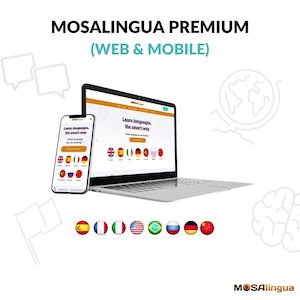Roughly 65% of the population are visual learners, which means you’re likely one of them. And even if you’re not, this article will teach you 4 ways to create powerful mental images that can help you improve your language learning and learn and remember vocabulary more efficiently.

You can also head over to the MosaLingua Language Lab podcast page to listen to this article:
Listen to “#23 – How to Use Mental Images To Improve Your Language Learning” on Spreaker.
What’s inside…
The Importance of Mental Images in Language Learning
Today I want to share one tip that I use and recommend to my language students when they’re learning new vocabulary: use mental images. You see, our brains function through images.
“What are mental images?”
Let’s do a quick test so you can see what I mean. I want you to think about your last trip to the store, and try to remember as many details as you can about that moment. Think of specific things like the items you purchased, whether you grabbed a basket or a cart, if you by yourself or with someone, and how did you pay at the register?
Take a few seconds to conjure up that trip. Close your eyes if you feel it helps.
Ok, done. Now let me ask you one question: how did you just remember this event in your mind? Was it in the form of words, sounds, or images? I bet you answered “images.” If you did, you’re probably a visual learner like me. Or maybe you received some other kind of input that triggered your memory. If so, I’d be curious for you to share in the comment section below this article!
Now that you know what I mean by “our brains function through images,” let’s take things to the next level and copy what memory geniuses do to remember things.
4 Tricks for Using Mental Images to Memorize Vocabulary
In general, slight food and lifestyle changes can make a huge difference in terms of how well your brain functions and remembers things. But in the language-learning domain specifically, one trick that helps you learn new phrases or vocabulary faster and more effectively is to associate them with mental images. For example, if you have to remember the French word soleil (sun), you’d increase your chances if you associated the word with a mental representation of the sun.
Would this always work? Maybe not… it’s too common and not memorable enough. Besides, for more abstract and difficult words, there isn’t always a simple picture that comes to mind. Fortunately, creating mental images that really work isn’t that complicated. I’m going to teach you how. Make sure those you create have one (or more!) of these characteristics:
- Exaggeration
- Unusual association
- Movement
- Emotional implication
Let’s go through each of these qualities so you can start applying them to your own language learning right away.
🧠 #1 Exaggeration
A good mental image must be exaggerated, having unusual dimensions or proportions. For example, if you want to memorize the word pied (“foot” in French), you can think of a man with one foot that’s much larger than the other. Or, if you want to learn the word unghia (“nail” in Italian), imagine a woman whose nails are so long they touch the ground! It’s hard to forget these kinds of images!
🧠 #2 Unusual association
To memorize the word “book,” think of a cat reading a book and holding it open between his paws. Or think of aliens wearing eyeglasses to remember the word “glasses” in Italian! I strongly recommend that you try this technique and think of it as a game – it can be really fun!
Start learning a new language today

Good news: we can help!
More good news: you can get started for free! Start your free trial now and for the next 15 days, take advantage of the most effective language learning method on the market!
Vocabulary flashcards, videos with subtitles, audiobooks, articles adapted to your level – with MosaLingua Premium (Web & Mobile), you’ll have access to all this and more. Get started right now. It’s free—and risk-free—to try!
🧠 #3 Movement
Did you know your attention is stimulated more by movement than by stationary things? This is why moving images are better recorded in your brain and makes them harder to forget. If you have to remember the word coche (“car” in Spanish), it’s best to imagine a moving car. Or, if you have to remember the word Pierre (“stone” in French), imagine a stone that’s constantly rolling… a “rolling stone”!
🧠 #4 Emotional implication
Emotions play a very important role in your memory. As you might have already realized, it’s extremely difficult to forget places linked with an intense experience or associated with moments of happiness or sadness. We’re often surprised that we can remember the smallest details of these memories, while we can pass the same building on the way to work without ever noticing its color or how many floors it has. If you were old enough at the time, I’m sure that you remember precisely where you were and what you were doing when you learned of the events of September 11th, 2001, which was a very emotionally charged day. That’s why every time I learn the word “dog” in a new language, for example, perro in Spanish, I associate this word with my dog Mika…
That’s it! See how easy these techniques are? What are you waiting for to create your own effective mental images? Share some of your ideas with us in the comments and let us know which of these techniques you prefer.
One last note: mental images are more effective if you create them yourself. The more personal they are, the easier they will be to remember. The act itself of conjuring a mental image will help you in the memorization process.
So, there you have it… be creative and have fun!
Video: How to Use Mental Images to Improve Your Language Learning
You can find all these tips in Lisa’s new video. It’s in English, but you can turn on subtitles by clicking on the Settings button (⚙️) at the bottom right. This video is available below or on our YouTube channel.
While you’re there, subscribe to our YouTube channel for more free learning content (and maybe even some guest appearances by Mika!)
If you’d like to go a little deeper, check out some of our other vocabulary-related articles:
- Learn more about The Spaced Repetition System (SRS), the technology behind the MosaLingua apps and the main reason they are so effective
- Find out how to combat the infamous Forgetting Curve
- 5 Simple Ways to Memorize Vocabulary
- And, when all else fails, What to Do If You Forget a Word During a Conversation




Comments